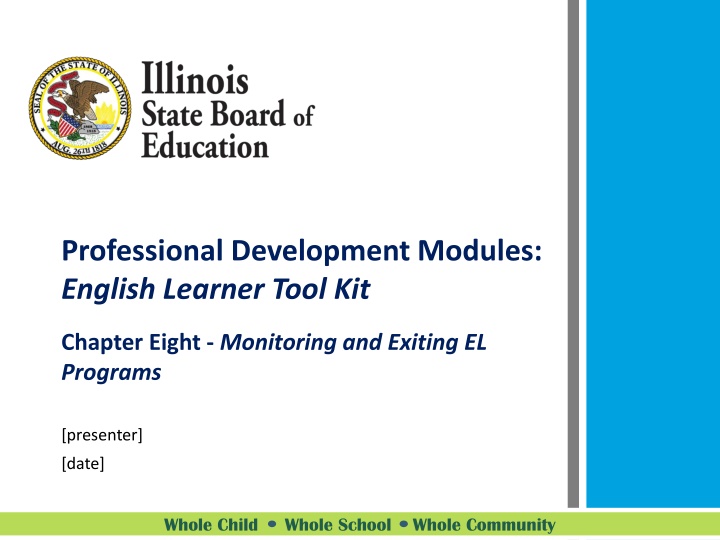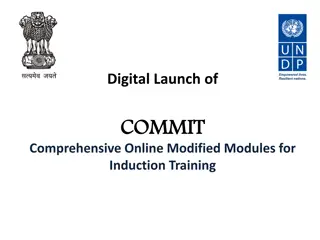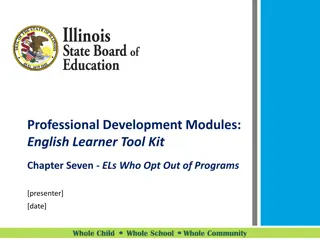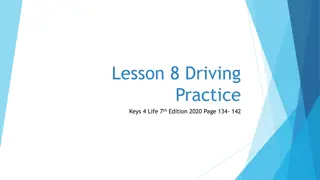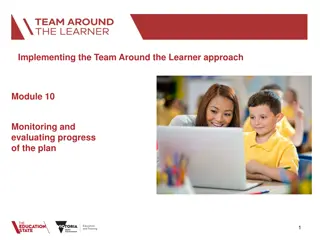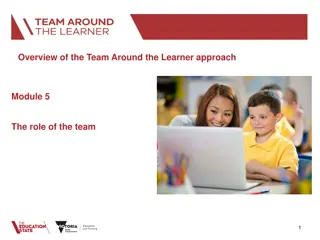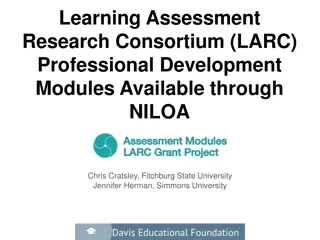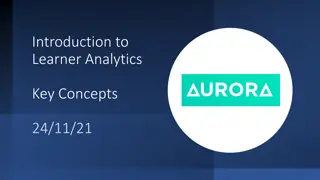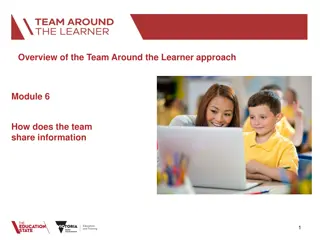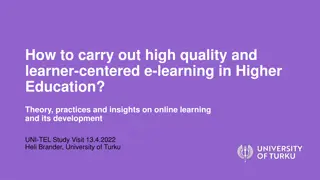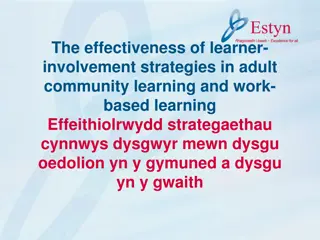Comprehensive Professional Development Modules for English Learner Support
This comprehensive professional development series focuses on supporting English learners in meeting their legal obligations and enhancing existing practices. It covers key topics such as identifying ELs, language assistance programs, staffing, monitoring, and exiting EL programs, all within the context of legal history and requirements. The modules aim to ensure equal access to education for all EL students and families.
Download Presentation

Please find below an Image/Link to download the presentation.
The content on the website is provided AS IS for your information and personal use only. It may not be sold, licensed, or shared on other websites without obtaining consent from the author.If you encounter any issues during the download, it is possible that the publisher has removed the file from their server.
You are allowed to download the files provided on this website for personal or commercial use, subject to the condition that they are used lawfully. All files are the property of their respective owners.
The content on the website is provided AS IS for your information and personal use only. It may not be sold, licensed, or shared on other websites without obtaining consent from the author.
E N D
Presentation Transcript
Professional Development Modules: English Learner Tool Kit Chapter Eight - Monitoring and Exiting EL Programs [presenter] [date] Whole Child Whole School Whole Community
Purpose The Professional Development Modules: English Learner Tool Kitis a series of presentations intended to provide guidance to help local educational leaders meet their legal obligations to English learners (EL) and enhance existing EL practices to meet the needs of all EL students, parents, and families. Whole Child Whole School Whole Community Whole Child Whole School Whole Community
English Learner Tool Kit Topics 1. Identifying All ELs 2. Language Assistance Programs 3. Staffing and Supports 4. Meaningful Access 5. Inclusive Environment 6. ELs with Disabilities 7. ELs Who Opt Out of Programs 8. Monitoring and Exiting EL Programs 9. Evaluation of EL Programs 10.Communication with EL Parents Whole Child Whole School Whole Community Whole Child Whole School Whole Community
Significant Legal History Title VI of the Civil Rights Act, 1964 Prohibits discrimination on the grounds of race, color, or national origin by recipients of federal financial assistance. The Title VI regulatory requirements have been legally interpreted to prohibit denial of equal access to education because of a language minority student's limited proficiency in English. Whole Child Whole School Whole Community Whole Child Whole School Whole Community
Significant Legal History Lau v. Nichols Court Case, 1974 Case dealt with San Francisco school system s failure to provide English language instruction to 1,800 students of Chinese ancestry. U.S. Supreme Court unanimously ruled that a lack of supplemental instruction for English learners denies them a meaningful opportunity to participate in educational programs, which violates the Civil Rights Act of 1964. Whole Child Whole School Whole Community Whole Child Whole School Whole Community
Significant Legal History Equal Educational Opportunities Act (EEOA), 1974 Prohibits states from denying equal educational opportunity to an individual on account of his or her race, color, sex, or national origin. The statute specifically prohibits states from denying equal educational opportunity by the failure of an educational agency to take appropriate action to overcome language barriers that impede equal participation by its students in its instructional programs. Whole Child Whole School Whole Community Whole Child Whole School Whole Community
There is no equality of treatment merely by providing students with the same facilities, textbooks, teachers, and curriculum; for students who do not understand English are effectively foreclosed from any meaningful education. Justice William Douglas
Legal Obligations U.S. Department of Education s Office of Civil Rights (OCR) and the U.S. Department of Justice (DOJ) share enforcement authority. Issued joint guidance in 2015 to help states, districts, and schools meet legal obligations to ELs. Guidance identifies 10 common civil rights issues for English learners. Whole Child Whole School Whole Community Whole Child Whole School Whole Community
Monitoring and Exiting ELs from Programs and Services Whole Child Whole School Whole Community Whole Child Whole School Whole Community
ENGLISH LEARNER TOOLKIT Chapter 8: Tools and Resources for Monitoring and Exiting English Learners from EL Programs and Services 10 KEY POINTS LEAs must monitor the progress of all ELs in achieving English language proficiency (ELP) and in acquiring content knowledge. LEAs should establish rigorous monitoring systems that include benchmarks for expected growth and take appropriate steps to assist students who are not adequately progressing towards those goals. SEAs must monitor LEAs to ensure that they are providing ELs meaningful access to grade-level core content instruction and remedying any academic deficits in a timely manner. Whole Child Whole School Whole Community Whole Child Whole School Whole Community
11 ENGLISH LEARNER TOOLKIT Chapter 8: Tools and Resources for Monitoring and Exiting English Learners from EL Programs and Services KEY POINTS LEAs must monitor the progress of all ELs in achieving ELP and acquiring content knowledge. LEAs should establish rigorous monitoring systems that include growth benchmarks and take appropriate steps to support students who are not adequately progressing towards those goals. Whole Child Whole School Whole Community Whole Child Whole School Whole Community
12 ENGLISH LEARNER TOOLKIT Chapter 8: Tools and Resources for Monitoring and Exiting English Learners from EL Programs and Services KEY POINTS SEAs must monitor LEAs to ensure that they provide ELs with meaningful access to grade-level core content instruction and remedying any academic challenges in a timely manner. Whole Child Whole School Whole Community Whole Child Whole School Whole Community
13 Additional Key Points: Exiting English Learners To exit a student from an EL program, the LEA must document that the student has demonstrated ELP using a valid and reliable assessment that tests all four language domains. In addition, the ESEA now requires LEAs to report on the number and percentage of former ELs meeting state academic standards for four years after students exit EL programs. Whole Child Whole School Whole Community Whole Child Whole School Whole Community
14 Additional Key Points: Exiting English Learners Students exiting from EL status must be monitored for at least two years, to ensure that: They have not been prematurely exited, Any academic challenges that students face as a result of participating in the EL program have been remedied, and They are meaningfully participating in the standard program of instruction, comparable to their never- EL peers. Whole Child Whole School Whole Community Whole Child Whole School Whole Community
15 ILLINOIS REQUIREMENTS Whole Child Whole School Whole Community
16 Tracking the Progress of English Learners The English language proficiency (ELP) of ELs is tracked annually for all ELs in grades K-12 Illinois uses the ACCESS for ELLs to measure EL s ELP and has set an overall composite score of 4.8 for reclassification. The ACCESS also aligns to Illinois ELP standards. Whole Child Whole School Whole Community Whole Child Whole School Whole Community
17 Tracking the Progress of English Learners Progress Reports: LEAs must send progress reports to parents or legal guardians of ELs in the same manner and with the same frequency as their non-EL peers Progress reports must describe the student's progress in the EL program and in the general program of instruction Whole Child Whole School Whole Community Whole Child Whole School Whole Community
18 Monitoring of Former English Learners Districts are required to monitor the academic performance of former ELs for at least two years after having exited EL services. The Illinois ESSA plan also requires school districts to report on the number and percentage of former ELs meeting state academic standards from the year ELs exit services until they graduate from high school. Whole Child Whole School Whole Community Whole Child Whole School Whole Community
19 Re-entry of ELs in EL Services If a student is exited from EL services but struggles to perform at grade-level due to English language needs, the student may be re-enrolled in an EL program upon a parent s request and based on the district s ability to service the student. Whole Child Whole School Whole Community Whole Child Whole School Whole Community
Pause and Reflect How do we monitor all ELs, including those who have opted out, at least annually for progress in achieving ELP and acquiring academic content? How do we monitor former-ELs performance in academic subjects? How do we communicate concerns to parents when former-ELs need additional EL services? Whole Child Whole School Whole Community Whole Child Whole School Whole Community
21 ADDITIONAL RESOURCES TO CONSIDER FROM THE EL TOOLKIT Whole Child Whole School Whole Community
Tools for Monitoring and Exiting English Learners Tool #1 Monitoring English Learner Progress in English Language Proficiency Provides an example of a monitoring form that can help determine if an EL is making appropriate progress, or needs additional support to attain English proficiency Whole Child Whole School Whole Community Whole Child Whole School Whole Community
Tools for Monitoring and Exiting English Learners Tool #2 Monitoring English Learner Progress in Core Content Areas Provides an example of a form that can help track an EL s educational progress in the content areas. Whole Child Whole School Whole Community Whole Child Whole School Whole Community
Tools for Monitoring and Exiting English Learners Tool #3 Digital Progress Monitoring Provides examples of five digital systems available online to monitor ELs progress. Whole Child Whole School Whole Community Whole Child Whole School Whole Community
Tools for Monitoring and Exiting English Learners Tool #4 Resources for Planning and Self-Assessments Provides reference tools, materials, and resources from the Office for Civil Rights (OCR). Whole Child Whole School Whole Community Whole Child Whole School Whole Community
Background Resources Fact sheet on the responsibilities of school districts Fact sheet answering common questions about the rights of limited English proficient parents and guardians Original OCR/DOJ guidance in Dear Colleague letter Translations into multiple languages All available at https://www2.ed.gov/about/offices/list/ocr/ellresources.html Companion toolkit from the Dept. of Education Office of English Language Acquisition: https://www2.ed.gov/about/offices/list/oela/english-learner- toolkit/index.html Whole Child Whole School Whole Community Whole Child Whole School Whole Community
27 Resources English Learner Toolkit (see Chapter 8 on monitoring and exiting English Learners): http://www2.ed.gov/about/offices/list/oela/english-learner-toolkit/index.html Dear Colleague Letter: Guidance to Ensure Equal Opportunities for English Learners: https://www.justice.gov/crt/guidance-ensure-equal-opportunities-english-learner- students IL School Code 14C for Transitional Bilingual Programs: http://ilga.gov/legislation/ilcs/ilcs4.asp?DocName=010500050HArt%2E+14C&ActID=1 005&ChapterID=17&SeqStart=119100000&SeqEnd=120600000 IL Admin. Code 228 for Transitional Bilingual Education: https://www.isbe.net/Documents/228ARK.pdf ISBE Guidance Document 228.27: Plan about Language Support Services: https://www.isbe.net/Documents/228-27_guidance_lang_svcs.pdf Whole Child Whole School Whole Community Whole Child Whole School Whole Community
28 Further Reading Abedi, J. (2008). Classification system for English language learners: Issues and recommendations. Educational Measurement: Issues and Practice, 27(3). Alvarez, L., Ananda, S., Walqui, A., Sato, E., & Rabinowitz, S. (2014). Focusing formative assessment on the needs of English language learners. San Francisco, CA: WestEd. Assessment and Accountability Comprehensive Center. (2009). Framework for high-quality English language proficiency standards and assessments.San Francisco, CA: WestEd. August, D., Estrada, J., & Boyle, A. (2012). Supporting English language learners: A pocket guide for state and district leaders. Washington, DC: American Institutes for Research. Bell, T. (2015). Sample digital monitoring systems. Silver Spring, MD: National Clearinghouse for English Language Acquisition (NCELA). Whole Child Whole School Whole Community Whole Child Whole School Whole Community
29 Further Reading Brown, J. E., & Sanford, A. (2011). RTI for English language learners: Appropriately using screening and progress monitoring tools to improve instructional outcomes.Washington, DC: U.S. Department of Education, Office of Special Education Programs, National Center on Response to Intervention. Callahan, R. M. (2005). Tracking and high school English learners: Limiting opportunity to learn. American Educational Research Journal, 42(2), 305-328. Color n Colorado. (n.d.). Assessment of English language learners [Webcast]. Color n Colorado. (n.d.). English language learners with learning disabilities[Webcast]. Color n Colorado. (n.d.). ELL starter kit for educators: Tools for monitoring language skills. Washington, DC: American Federation of Teachers. Whole Child Whole School Whole Community Whole Child Whole School Whole Community
